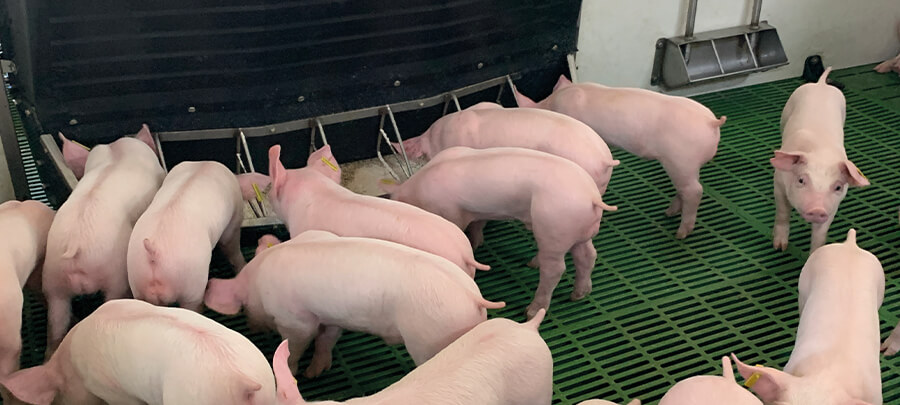Blog
Blog

Keys to nutrition at weaning
18th July 2023 - News
The weaning stage is one of the most delicate and nutritionally demanding in the piglets’ life. Its intestinal system is extremely young and its stomach is poorly developed, since until that moment its diet has been, basically, liquid. Given this situation, what are the main challenges and threats? We talked about it with Juan Gabriel Espino, an animal nutritionist in Guatemala that specialises in pigs and poultry.

Juan Gabriel Espino, animal nutritionist. Photo: Rotecna.
From the gastrointestinal physiology point of view, what does the weaning phase mean for the piglet?
If we break it down into parts and start with the stomach, we find the transition from a liquid diet, with milk, to a solid diet. So, it is a stomach that has to adapt to the change in food texture. The adaptation usually takes one to three weeks, depending on the development of each piglet. At the intestinal level, the change is also quite strong because the protein and carbohydrate configuration is more complex, and the enzymatic package of the piglets does not finish configuring itself until the fourth or fifth week. If we continue down along the gastrointestinal rectum, upon arrival at the colon we find a microbiota that must also adapt to the new food that arrives.
How should the piglet's diet be at this stage?
When a small animal starts eating, we seek to give it a highly digestible diet for the first two to three weeks. Then, as the piglet matures, the configuration of the diet changes and this is how its adaptation is best achieved. There are different phases in diets and feeding programs so that as the piglet progresses, it is provided with food that matches its age and intestinal physiological development.
What trends currently exist in terms of weaning piglet nutrition?
I would say that the most important trends that are becoming more relevant are, first of all, the substitution of some protein sources, since there are now many studies of soybeans and alternative ingredients. Secondly, there is the use of fibre, which is also important to consider in the design of a diet for the piglet. Thirdly, along those lines, there would be the substitution of growth agents or similar molecules. In the end, everything is focused on achieving a good weight at weaning.
At weaning, is it better to work with multiphase feeding systems?
The idea of multiphase feeding is to provide the amount of protein that the piglet needs. You can't just give it one type of feed in one phase or one pre-start feed to the whole program because you'd be wasting money. The idea is that as you ascertain when the change can be made, the protein is decreased and the diet that corresponds to the physiological age of the piglet is integrated according to your feeding program and the needs of the farm.
What digestive diseases do we find at weaning? How can nutrition help prevent them?
Mainly, pre and post-weaning diarrhoea are caused by E coli, although it is also quite common to find some cases of clostridium. On the other hand, there are viral diseases, although bacterial diseases are the most abundant during the weaning phase. To avoid its appearance, we have many things that can help us. There are Vitamins (A and E), which are not only used in different metabolic cycles but also work for antioxidant issues at the intestinal level. On the other hand, we have minerals that play an essential role in their growth, and protein that is important for the construction of many building blocks of tissue on a physiological level.
"The idea of multiphase feeding is to provide the amount of protein that the piglet needs. You can't just give it one type of feed."
How can you help avoid those diarrhoeas, so common during weaning?
We have lignocellulose, which is classified as an insoluble fibre with low fermentation that greatly stimulates water consumption. It is an additive that allows one to regulate the efficiency of the gastrointestinal system and that not only works in the stomach but also contributes to making the entire gastrointestinal system more efficient. In the stomach, it allows a better adaptation to a solid diet since this additive can make the stomach develop faster. In addition, it helps food flow downwards, preventing intestinal ecstasy, promotes glucose and protein absorption, and fosters the ability to produce amylases. When we reach the colon, it enables a lot of colonic retention helping the circumscribed bacteria to remain there and not migrate to the upper tract, thus avoiding many problems such as E coli.
Are there other additives that help reduce diseases?
There are organic acids, which are very important due to the lack of acidity in the piglet's gastrointestinal tract, phytobiotics or alternative growth agents, and essential oils, which could help reduce the use of growth agents. On the other hand, there are vitamins, which are also very important in the proliferation of certain epithelia. In summary, many things can be used to improve the intestinal integrity of the piglet.
What effect has the withdrawal of zinc oxide had?
Perhaps it forced us to look for other alternative sources and replacements that promote that correct modulation of the intestinal microbiota, which in the end is what we pursue. It is now much easier to find how to replace it because there are tools that can help stimulate that changeover successfully.
At the nutritional level, what are the main challenges during this phase?
I would go a little further back from weaning. It is important to get the piglet to wean with a good weight. If that is achieved, we will already be halfway there. So, the key is a good weight, but to maintain it, the challenges are that the piglet will have to have a correctly modified diet so that it does not feel a very abrupt change in feeding. To this purpose, farm equipment is extremely important because in the end, if you do not have the right equipment, nutrition is useless. If there is good nutrition and good equipment, it will be possible to ensure that the transition at weaning is not so dramatic and without such high mortality.






